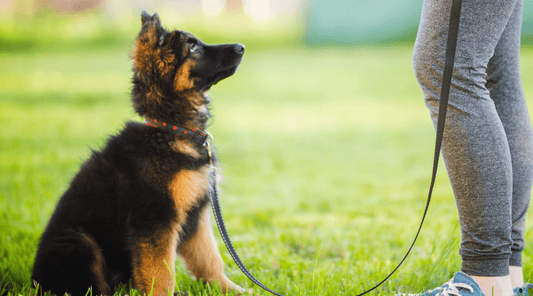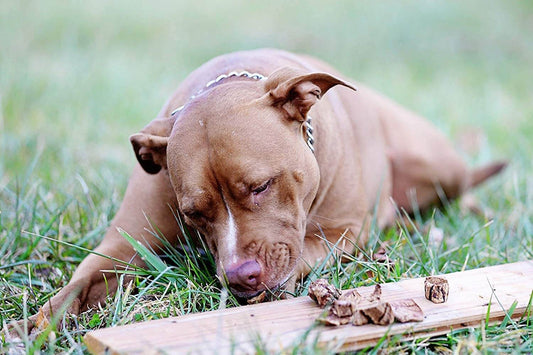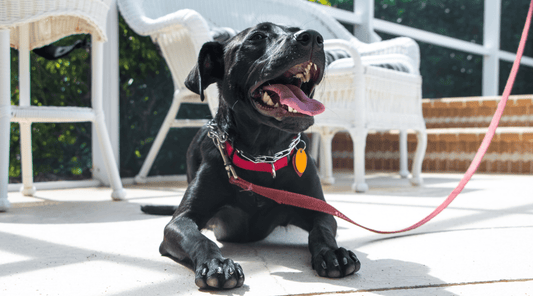
Dog Sleeping Positions: What's Your Dog’s Snooze Style
Dawn Miller Mar 27, 20254 Minute ReadHumans are curious. Sometimes, we find meaning in the most random behaviors. But when it comes to dog sleeping positions meaning, there may really be something behind belly up vs down or legs in or out.
The other night, I looked over at Pixie and couldn’t stop laughing.
She was sleeping on her back, legs straight up in the air, looking like a very dramatic, upside-down starfish. I imagined she was dreaming about playing dead and got stuck that way.
Bruno? He was curled up in a perfect donut on his dog bed, while my other dog (who shall remain unnamed because he likes his privacy and I respect that) was snoring with his tongue out. 3 dogs. 3 very different dog sleeping positions.
Dog Sleeping Positions: What Your Dog's Sleep Style Tells You
1. The Donut
What it looks like: Your dog is curled into a tight ball, tail tucked, nose touching their paws.
What it means:
- They may feel cold
- They like to feel safe and secure
- Might be a little anxious or adjusting to a new environment or housemate
Fun fact: Wolves and wild dogs sleep this way to protect their vital organs from attack and to conserve heat. I've always thought my lab mix, Bruno, was cold-natured. He's my donut sleeper and only sprawls to sleep in the summer months.
If you think this sleep pattern may indicate anxiety or adjustment to a new environment or pack members, give them a single-ingredient beef marrow dog bone to chew on a few times a week. This feeds their need to chew, which can alleviate anxiety and bonus—stop destructive chewing too.
2. The Superman
What it looks like: Your dog is lying flat on their belly, front and back legs stretched out like they’re ready to take off into the sky.
What it means:
- They’re resting but staying alert—ready to jump up at a moment’s notice to catch a squirrel or fend off an attack.
- Puppies and high-energy dogs love this position because it lets them recharge quickly.
- Your dog loves to play and sleep in only an inconvenience for them.
Make sure your dog is getting plenty of exercise. Consider lengthening walks and adding a 5-minute dog training session to engage and mentally stimulate them. Schedule a few dog bone chew times each week to let them work out some of that energy with their natural chewing instinct.
3. The Side Sleeper
What it looks like: Your dog is lying on their side, legs stretched out, completely relaxed.
What it means:
- They feel safe, comfortable, and secure.
- They’re in deep sleep mode, fully trusting their surroundings.
- They’re likely well-adjusted and relaxed in their home.
Does your dog sleep like this some or all of the time? Congrats—they’re super comfortable around you!
Sounds like your dog trusts you fully and looks to you for guidance. You can leverage this trust to teach your dog useful dog commands, tricks, and skills that strengthen your communication and your bond.
4. The Upside-Down Starfish
What it looks like: Your dog is on their back, legs flopped open, looking like they’re waiting for a belly rub in their dreams.
What it means:
- Ultimate relaxation—they’re completely at ease.
- It helps them stay cool since their belly is exposed.
- Dogs who sleep like this trust their environment 100%.
Warning sign: If your dog suddenly stops sleeping this way, they might be feeling stressed or uncomfortable. Strengthen your connection with your dog with positive reward training.
I'm more likely to see my terrier Pixie like this in the summertime or when lounging near the fireplace.
5. The “Leaning Against You” Position
What it looks like: Your dog sleeps pressed up against your side, like a fluffy, four-legged shadow.
What it means:
- They love you and want to feel close.
- They’re looking for warmth and comfort.
- Could be a sign of mild separation anxiety.
If they ONLY sleep touching you? Work on confidence training so they feel okay being alone sometimes. Establish a more consistent routine for meals, walks, exercise, cuddles, etc. This helps a dog better predict your actions. So, they feel confident leaving your side to do their own thing more often.
How Much Sleep Do Dogs Need?
Does your dog seem like they're sleeping all the time? There's a reason for that. Just look at their sleep requirements compared to an adult human's 7-9.
🐶 Puppies & senior dogs – 16 to 20 hours a day
🐕 Moderately active adult dogs – 12 to 14 hours a day
🐩 Active working dogs – 10 to 12 hours a day
Dog sleep cycles are also different. They tend to nap several times during the day and can quickly jump up to full alertness within seconds after a short rest.
They may sleep a little longer at night when you're asleep. But they're still likely to wake up and walk the perimeter to make sure you're protected while you sleep.
Dog Sleeping Positions When Sick: What to Watch For
Now, I don't know how much attention you've been paying to your dog's sleeping position before today. But you might have noticed a change. If your dog suddenly changes sleeping positions and sleep habits, it could be a sign of discomfort or illness.
- If they're middle-aged or an arthritis-prone breed, they could be having joint pain.
- If they seem restless, they could be anxious about a new environment or housemates—or in general.
- If they start sleeping in weird places, they could be developing cognitive issues.
- If they're pacing a lot at night while you're in bed, they may have some anxiety.
If something seems off, always check with your vet! But the following can also help.
For suspected joint pain:
-
Start them on joint supplements, before you see these signs, if possible. I choose single-ingredient beef trachea chews. These all-natural chews contain glucosamine, collagen, MSM, chondroitin, as well as some anti-inflammatory omega 3 fats.
-
Consider whether they need a new, thicker bed. My lab mix Bruno loves his rug. But as he gets older, I will encourage him to use a dog bed instead.
-
Make sure they're getting regular exercise. Sedentary or overweight dogs will often struggle to find comfortable sleep positions. Consider adding a 5-10 minute dog training session to apply positive reinforcement. You can teach them not only basic commands but also active games that get them moving more.
Now sure where to start on training? Be sure to join the 7-Day Dog Training Challenge. You'll learn how to effectively use positive reinforcement training and your dog can earn awards for each skill they learn.
For suspected anxiety:
- Supplement their nutrition with omega 3, B vitamins, antioxidants, and protein. I choose grass-fed beef marrow dog bones and dog treats because they're single-ingredient and help fill in the gaps, or I would choose an all-kibble diet.
- Make sure your dog has something to chew on several times a week. Dogs relieve anxiety by chewing.
- And, of course, regular exercise, routine, and dog training are critical for building confidence and easing stress.
Available On:


Disclosure: This article may contain affiliate links, which means we may earn a small commission if you make a purchase through these links—at no extra cost to you. We only recommend products we trust and believe will benefit you and your K9.



